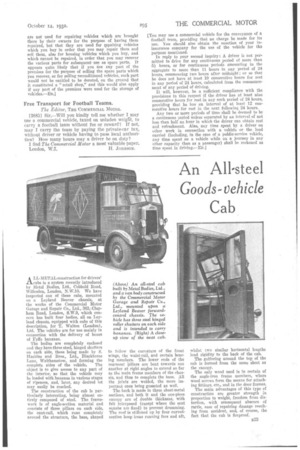An Alkteel
Page 49

If you've noticed an error in this article please click here to report it so we can fix it.
Goodsvehicle
Cab
11A L LL-META construction for drivers'
cabs is a system recently introduced by Metal Bodies, Ltil., CobboId Road, Willesden, London, N.W.10. We have inspected one of these cabs, mounted on a Leyland Beaver chassis, at the works of the Commercial Motor Garage and Repair Co., Ltd., 363,,Clapham Road, London, 8.W.9, which concern has built four bodies, all on Leyland chassis, equipped with cabs of this description, for T. Walton (London), Ltd. The vehicles are for use mainly in connection with the delivery of boxes of Fyffe bananas.
The bodies are completely enclosed and they have three steel, hinged shutters on each side, these being made by S. Haskins and Bros., Ltd., Blackhorse Lane, Walthamstow, and forming the complete sides of the vehicle. The object is to give access to any part of the interior, so that the vehicle may be loaded with bananas in various stages of ripeness, and, later, any desired lot may easily be reached.
The construction of the cab is particularly interesting, being almost entirely composed of steel. The framework is of angle-section material and consists of three pillars on each side, the cant-rail, which runs completely around the structure, the base, shaped
to follow the curvature of the front wings, the waist-rail, and certain bracing members. The lower ends of the rearmost pillars are bent towards one another at right angles to extend so far as the main frame members of the chassis, and thus to complete the base. All the joints are welded, the more important ones being gusseted as well.
The back is made in three sheet-metal sections, and both it and the one-piece canopy are of double thickness, with felt interposed (except where the seat squabs are fixed) to prevent drumming. The roof is stiffened up by four curvedsection hoop irons running fore and aft, whilst two similar horizontal lengths lend rigidity to the back of the cab.
The guttering around the top of the cab is formed from the same sheet as the canopy.
The only wood used is in certain of the angle-iron frame members, where wood screws form the means for attaching fittings, etc., and in the door frames.
The main advantages of this type of construction are greater strength in proportion to weight, freedom from distortion, with consequent absence of rattle, ease of repairing damage resulting from accident, and, of course, the fact that the cab is fireproof.




































































































